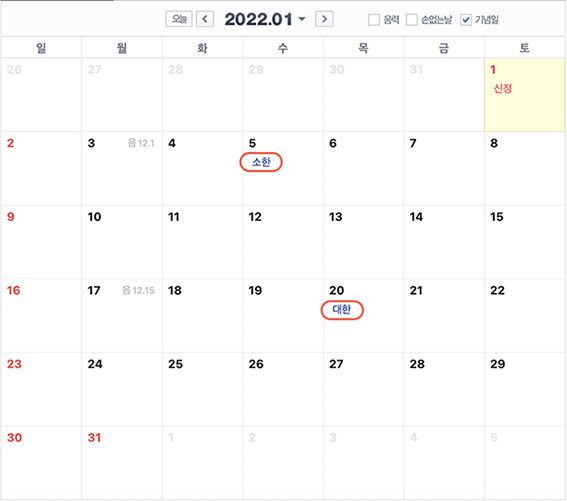
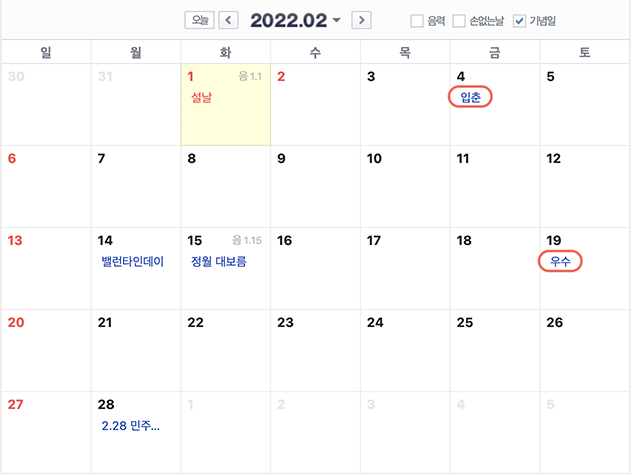
These are the examples of the calendar that I’ve used my whole life growing up in Korea. We use the Gregorian calendar, but most holidays and traditional customs are based on the lunar calendar. This was pretty much all I knew, and I’ve never paid attention to why and how this works. Since my research inquiry is focused on exploring the relationship between the use of time and sustainable living, I decided to return to my root and dive deep into the usage of the lunar calendar and traditional Korean culture interacting with the natural environment.
Lunisolar Calendar
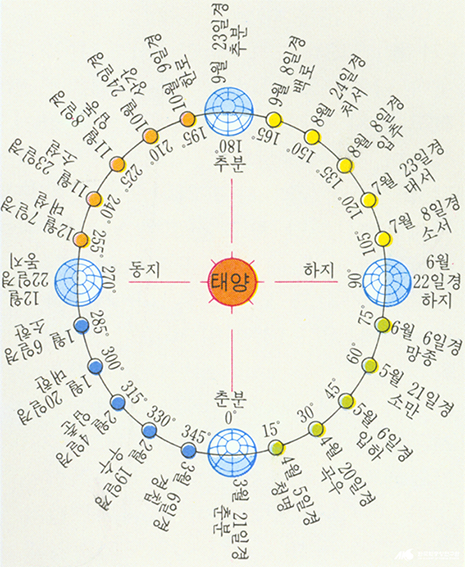
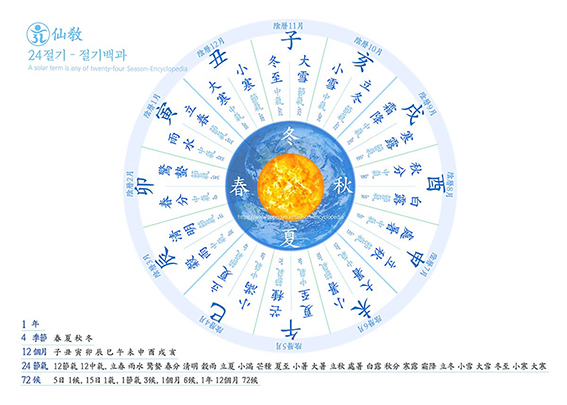
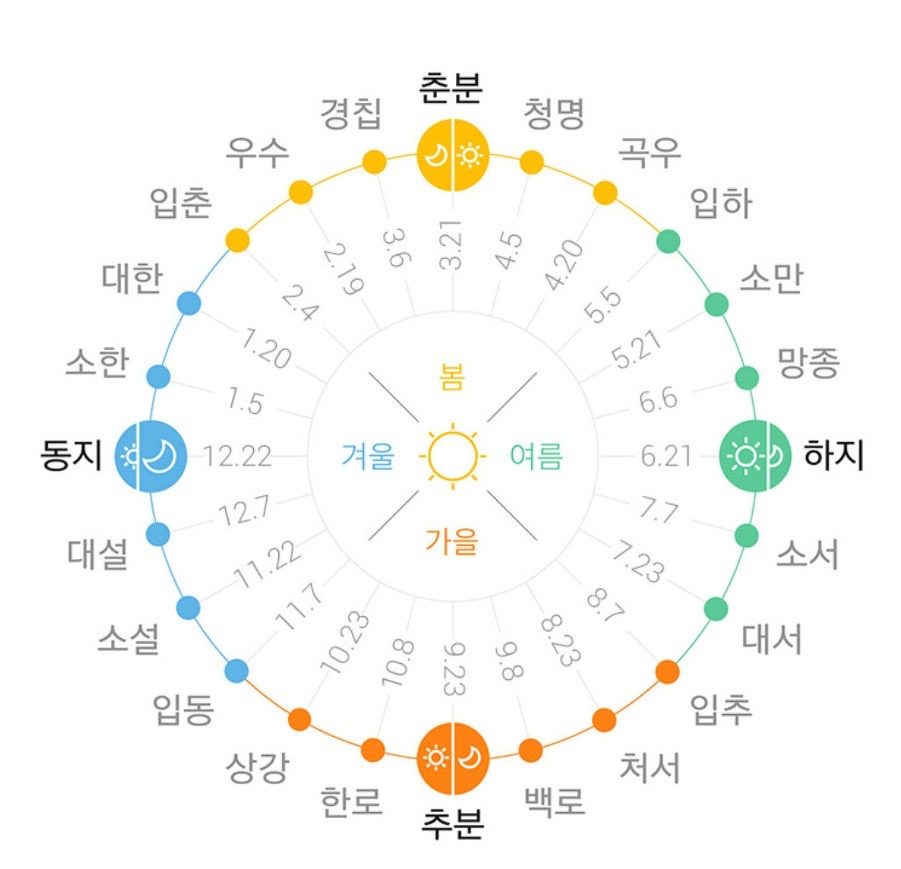
Little did I know, our traditional calendar was actually a lunisolar calendar. The date of lunisolar calendars indicates both the Moon phase and the time of the solar year, which is the Sun’s position in the Earth’s sky. A solar term is a period of approximately fifteen days that takes the sun to travel along 15 degrees of its annual circuit around the zodiac. That was why we had two dates marked in each month to indicate these seasonal divisions.
I also discovered the names and explanations of seasonal divisions are based on the climate of the Zhou dynasty, which is Huábei region (Northern part of China,) and Korea has been using the Gregorian calendar since 1896.
24 Seasonal Divisions
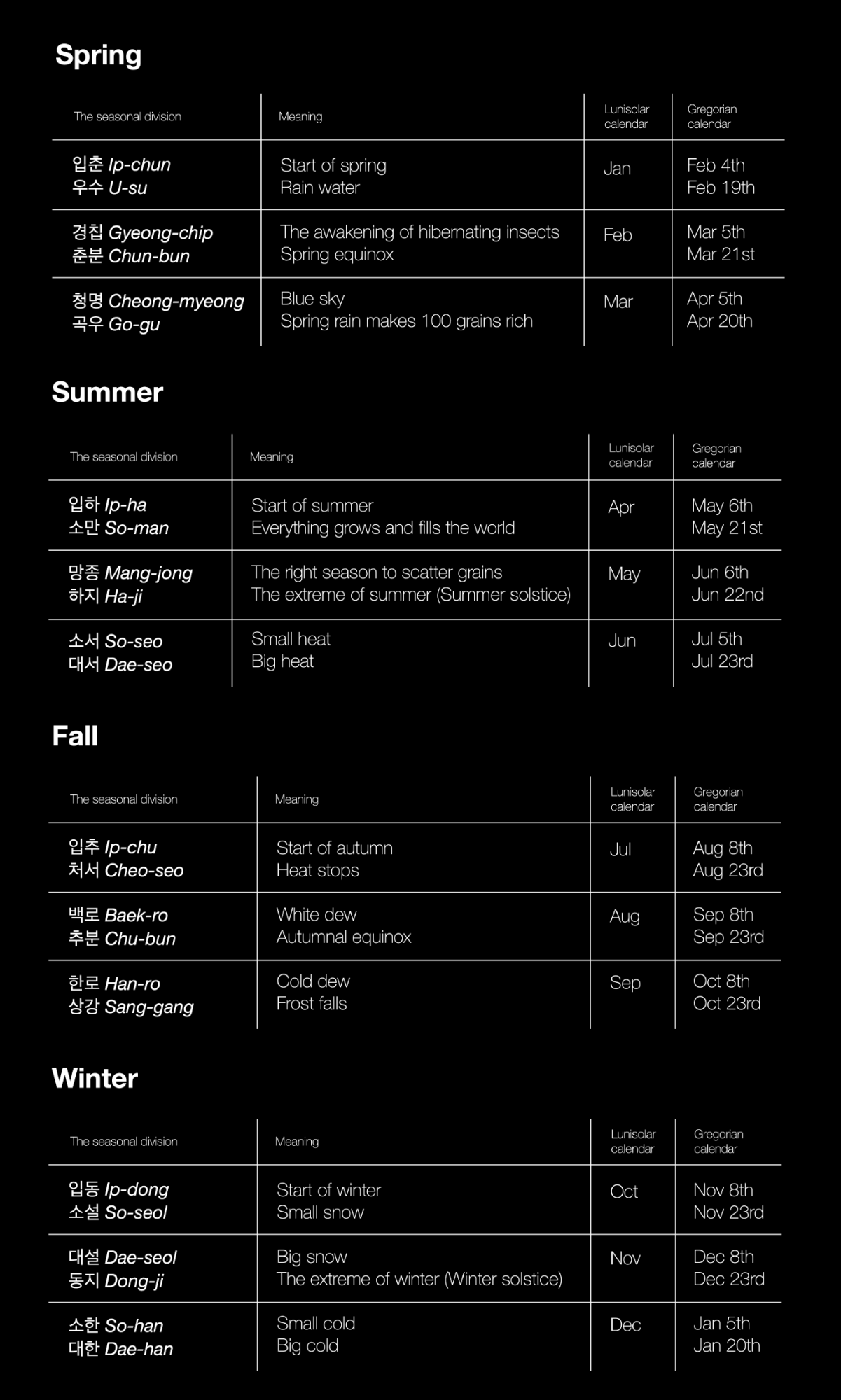
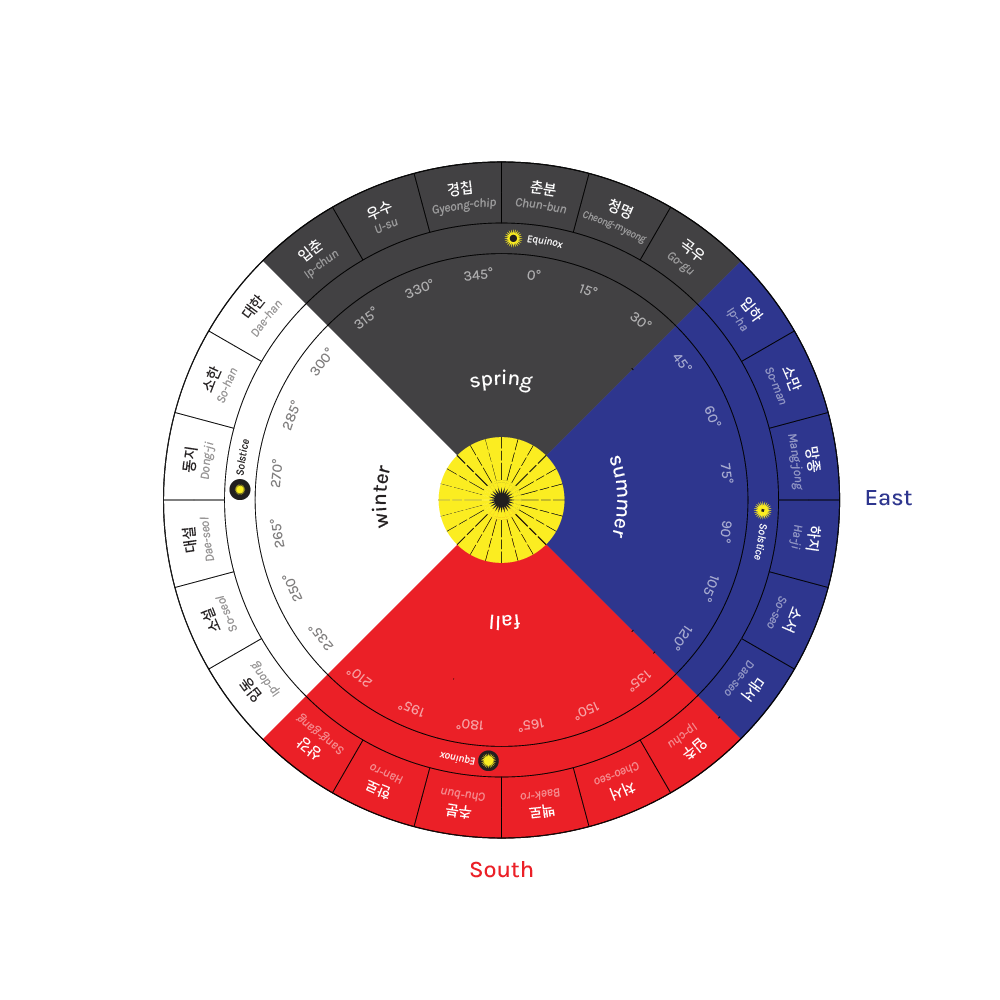
In the lunisolar calendar, spring starts in January and winter ends in December (You can compare the equivalent dates of the Gregorian calendar in the table chart). Each of the 24 seasonal divisions holds meanings that convey rich interaction with nature. As I mentioned briefly, these seasonal divisions are based in Huáběi region (Northern part of China) so the dates and meanings don’t exactly match with the climate in Korea. Translating the original meanings of the Chinese names and exploring how they’ve been used in Korean was quite an eye-opening experience. I realized adapting this calendar system into the Korean environment also influenced our language and created numerous idioms and proverbs.
Natural changes in climate were significant in traditional agricultural societies like Korea, which is why 24 seasons were utilized. Compared to the lunar calendar, using the position of the sun to divide the seasons allowed people to know the exact trend of climate. We have a saying called “철이 들다 chori deulda“ which means you are matured and grown up as an adult. I’ve been using this phrase in my entire life without comprehending that 철 chor is another term to call season and -이 들다 i deulda means being coloured, influenced. Back in the day, the true indication of being a grown-up person was being influenced by the seasons to understand the land and the cyclical flow of farming.
#6 Spring Seasons
I started collecting traditional customs for each seasonal division to understand how people interacted with the lunisolar calendar in the past. I also wanted to find a historical reference of the climate of seasons to get a better sense of the natural environment at that time.
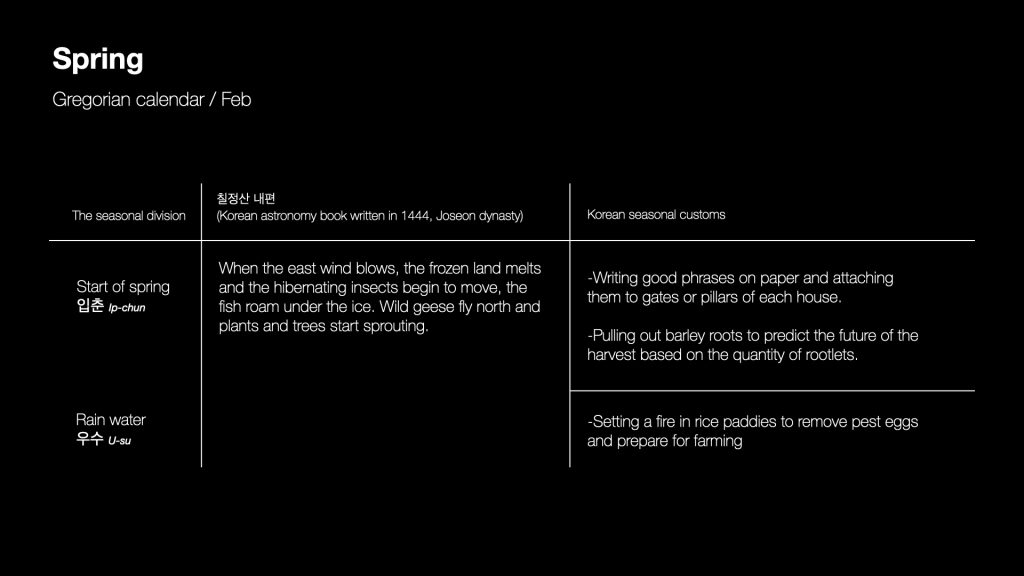
- 입춘 Ip-chun (Start of spring) Ip-chun is one of the seasonal divisions that it’s still commonly used and referenced in Korean culture up to this date. All I knew about Ip-chun was this is when the weather starts to warm up. Since it is the first season of the new year, one of the traditional customs that still happens on Ip-chun is writing good phrases on paper and attachting them on doors, wishing good luck to come.
- 우수 U-su (Rain water) U-su means that snow melts and becomes rain water, which indicates the cold winter has gone and the spring has come.
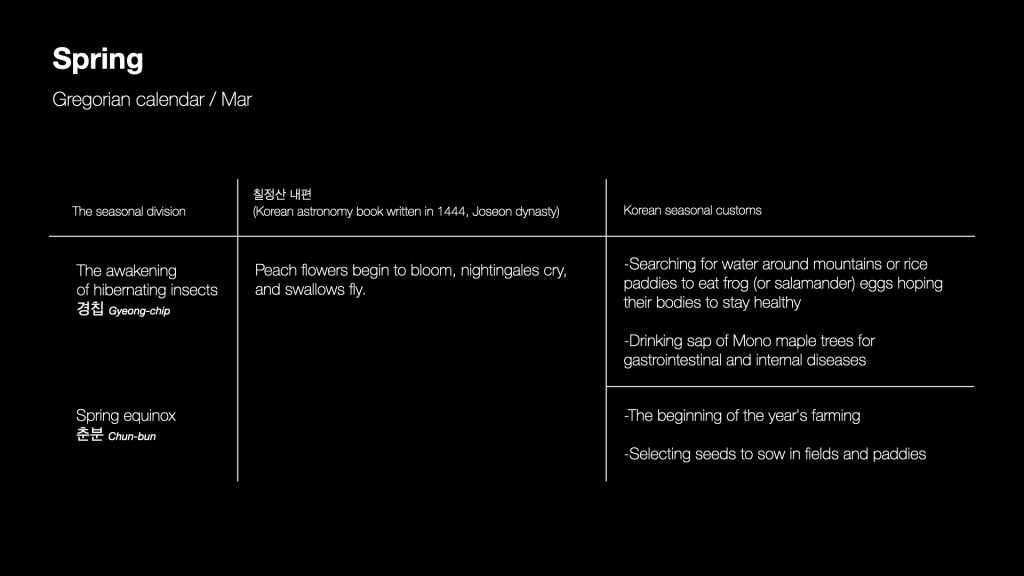
- 경칩 Gyeong-chip (The awakening of hibernating insects) Gyeong-chip means that hibernating insects under the ground come out surprised by the sound of thunder and lightning. In Korea, due to the climate difference, it is known to be the time that frogs wake up from hibernation because people could start to hear them crying. People also believed eating frog eggs will keep them healthy. Drinking Mono maple tree sap is another traditional custom in the southern region of Korea during this season. People thought they could receive new energy of the year by drinking the first early spring sap that starts to rise in the trees.
- 춘분 Chun-bun (Spring equinox) Chun-bun is when the Sun is exactly above the Equator and day and night are of equal length. This is the time the year’s farming officially begins. Farmers start to plant spring barley and collect wild leaves and herbs to eat.
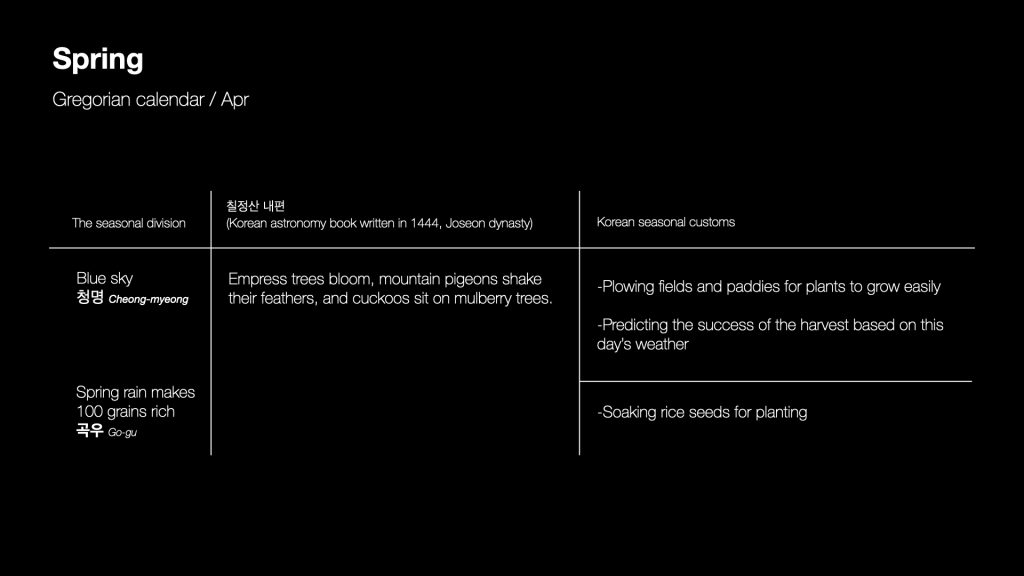
- 청명 Cheong-myeong (Blue sky) Cheong-myeong is the season that means the sky gradually clears up. People start plowing fields and paddies to grow grains and vegetables easily. There are also many weather-related myths in various regions since it is an important time to plan farming.
- 곡우 Go-gu (Spring rain makes 100 grains rich) By the time of Go-gu, the farming season begins in earnest by preparing rice seeds. There are various proverbs related to farming around Go-gu, such as “All grains wake up on Go-gu,” and “When it rains on Go-gu, there is a good harvest in the year.”
#6 Summer Seasons

- 입하 Ip-ha (Start of summer) Ip-ha is the beginning of summer. This is the time when earthworms wriggle in the yard, oriental melon flowers begin to bloom, and the sprouts of rice seeds grow in full swing. People are in the midst of silkworming inside of the house, and busy pulling out weeds in fields and paddies.
- 소만 So-man (Everything grows and fills the world) So-man means that the sun is abundant and everything grows in full. Around So-man, people are busy preparing rice transplanting. This is the season when barley sprouts grow, and wild plants bloom, bear fruit.
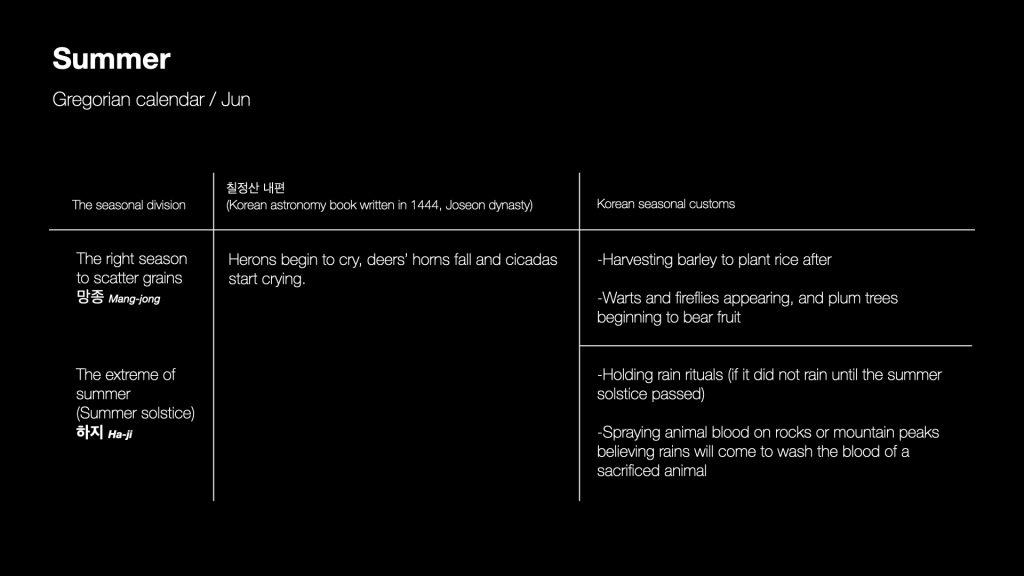
- 망종 Mang-jong (The right season to scatter grains) Mangjong means it is the right time to sow seeds of grain with beards like rice. Around the time of Mangjong, people harvest barley and plant rice in paddies.
- 하지 Ha-ji (The extreme of summer) Summer solstice Ha-ji means the extreme of summer since it is the day of summer solstice. The sun rises highest and the length of the day is the longest so the surface of the northern hemisphere receives the most heat from the sun. In Korea, this is when the monsoon season usually starts hence drought often continue until before and after Ha-ji. The central part of Korean agriculture is rice farming, so rain is what determines the success or failure of farming. Therefore if it doesn’t rain until the summer solstice passes, rain rituals were held and various indigenous methods were mobilized.
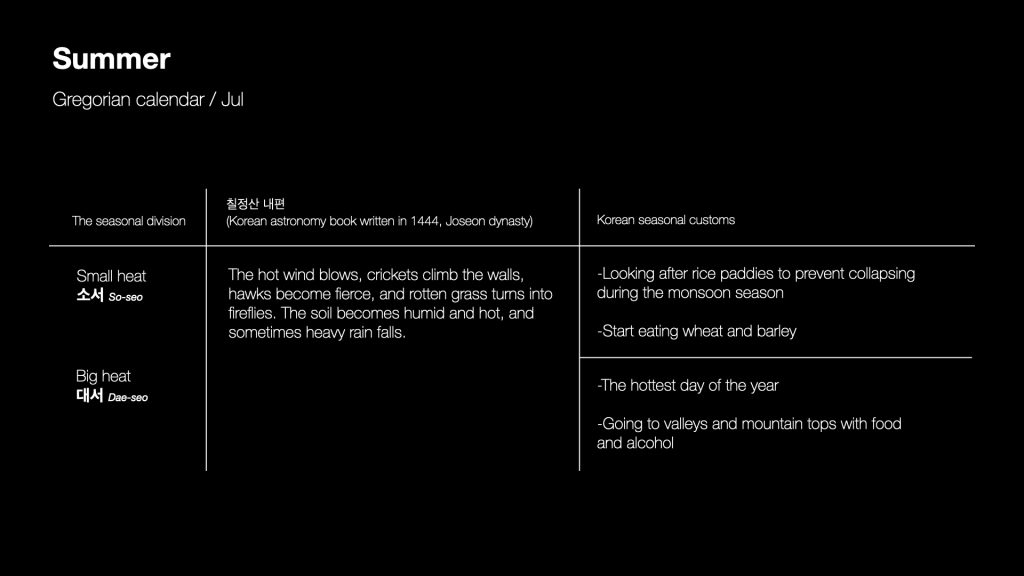
- 소서 So-seo (Small heat) So-seo means small heat which connotates the summer heat begins around this time. Meanwhile it’s still the rainy season in Korea so humidity is still very high. Transplanted rice take root in the ground so people pull out weeds and look after the paddies.
- 대서 Dae-seo (Big heat) Dae-seo means big heat. The rainy season is over in Korea and the weather starts to get really hot around this time. There is an old proverb that says “Goat horns also melt because of the heat.” There is a custom that people visit valleys or mountains to drink alcohol and eat nutritious food to avoid the heat and stay energetic. Around Dae-seo, late July and early August, is still the peak of summer holiday seasons in Korea up to this date.
#6 Fall Seasons
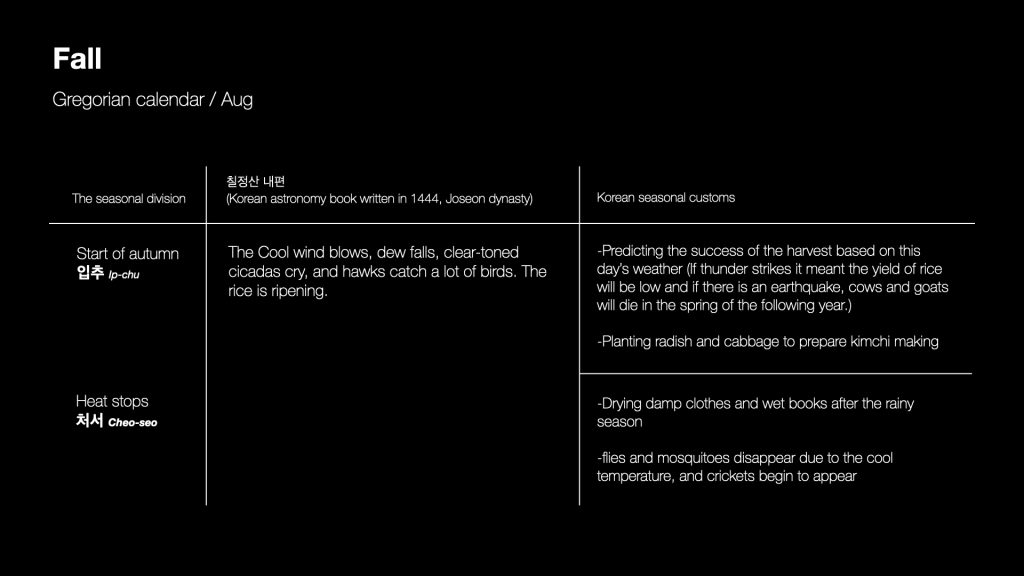
- 입추 Ip-chu (Start of autumn) Ip-chu means the beginning of autumn and it’s a time when rice is in full swing. Farmers hoped for continuous clear weather and they thought they can predict the success of the harvest based on the weather on this day. Cool winds begin to blow at night after Ip-chu so people start getting ready for autumn. In particular, radish and cabbage are planted around this time to prepare making Kimchi in November.
- 처서 Cheo-seo (Heat stops) Cheo-seo means the heat goes away and fresh autumn comes. After this season, the scorching sun softens and weeds no longer grow, so people mow grass in the rice paddies and ancestors’ graves. People used to dry damp clothes and books since the rainy season is over. The air starts to feel cool and fresh in the early morning and late night, so there is a proverb that goes “Mosquitoes’ mouths become crooked after Cheo-seo.” Just like it says, flies and mosquitoes start to disappear, and crickets begin to appear one by one due to the coolness of Cheo-seo.
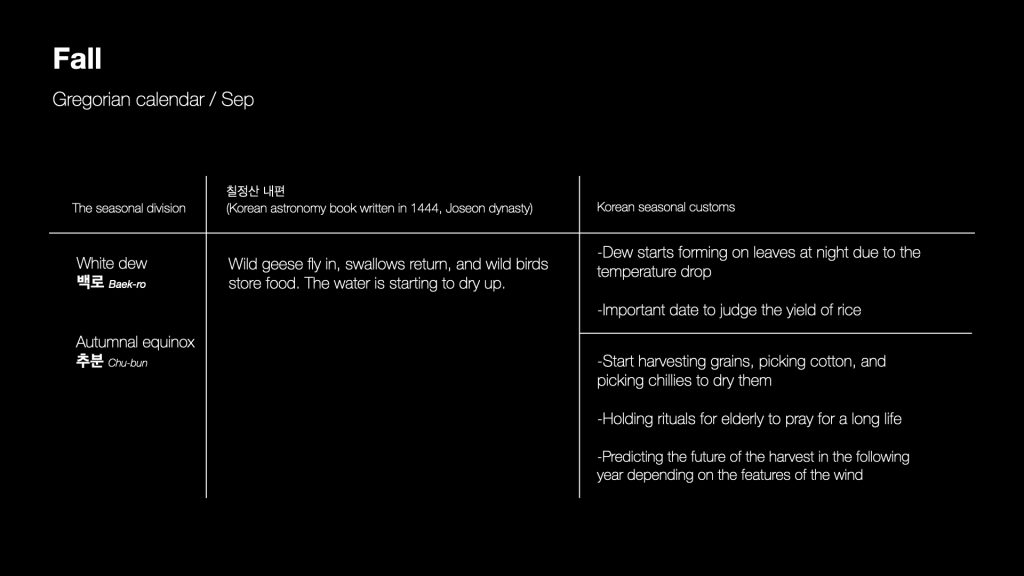
- 백로 Baek-ro (White dew) Baek-ro means white due since you start to see dew forming on leaves at night around this time. Rice should be ripened before Baek-ro at the latest because when winds become cold and frost begins to fall, it’ll affect the yield of rice. Therefore, especially around this time farmers carefully observe the way wind blows to predict the success of the harvest.
- 추분 Chu-bun (Autumn equinox) Chu-bun is when the length of the day and night become the same again. People were aware of this day as a turning point of the season because after the autumn equinox the night gradually gets longer. Autumn equinox and spring equinox are both the same length of day and night, but when it comes to temperature, the autumn equinox is about 10 degrees higher. This is because the heat of summer still lingers.
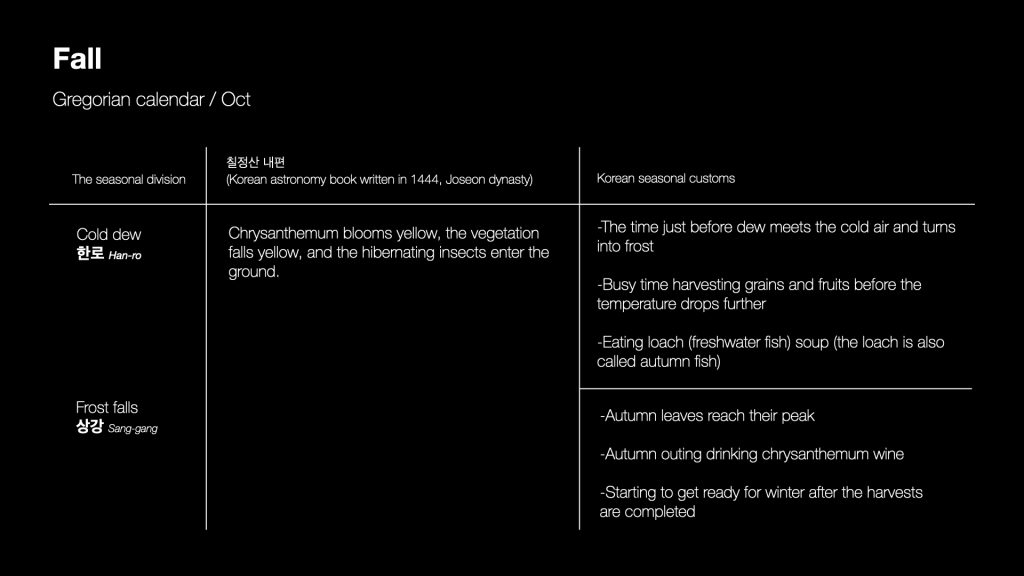
- 한로 Han-ro (Cold dew) Han-ro means cold dew since it’s the season the dew meets cold air and turns into frost as the air gradually cools down. The harvest must be completed before the temperature drops further, so rural areas are in full swing of harvesting. Around the time of Han-ro and Sang-gang, people also enjoy a loach soup called chu-eo-tang around this season, which translates to autumn fish soup.
- 상강 Sang-gang (Frost falls) Sang-gang is the season when the temperature at night drops quite low in contrast to sunny autumn weather during the daytime. This is the late autumn season so colourful autumn leaves reach their peak and chrysanthemums are in full bloom. Sang-gang is also the end time of the harvest of the year, so people slowly start getting prepared for the winter.
#6 Winter Seasons
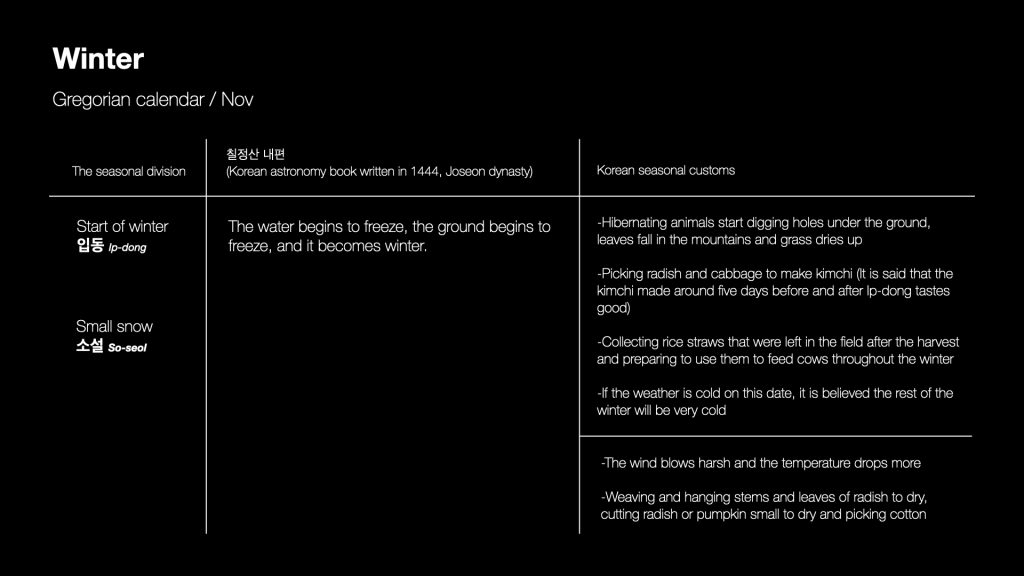
- 입동 Ip-dong (Start of winter) Ip-dong means winter begins from this day. People cut rice straws and make them into porridge to feed cows since the grass dries up in winter. People also pull out radishes and cabbages from the field to make kimchi. It is said that the kimchi made around five days before and after Ip-dong tastes the best. However, kim-jang-chul (kimchi-making season) is now almost the end of November, perhaps due to climate change.
- 소설 So-seol (Small snow) So-seol means small snow since the first snow falls around this season. This is the time when proper cold begins so people used to rush making kimchi before So-seol.
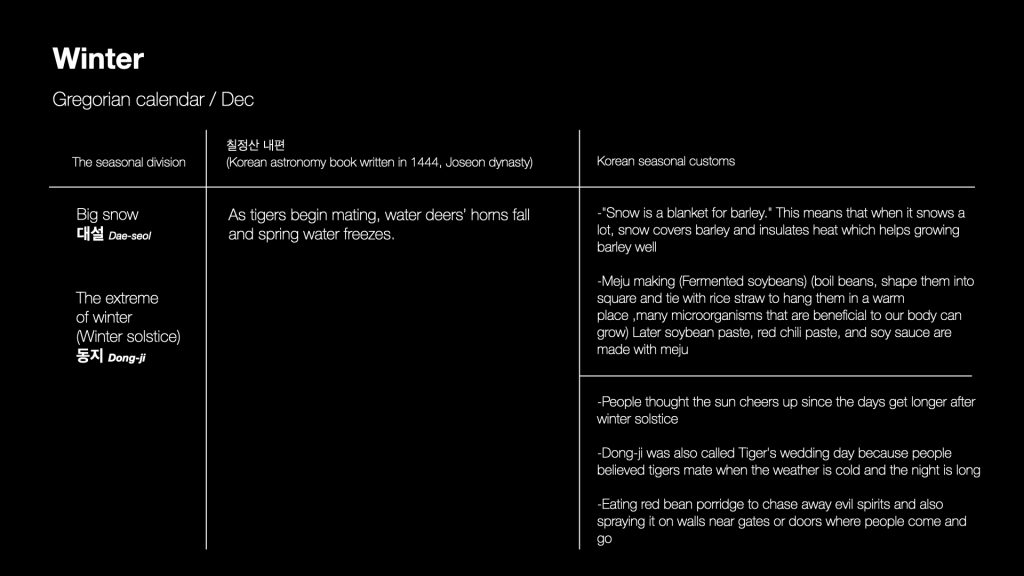
- 대설 Dae-seol (Big snow) Dae-seol means big snow since it starts to snow heavily. We don’t necessarily have a lot of snowfall during this season due to the climate difference from China’s Huáběi region. People start fermenting soybeans to make Meju. Soybeans are boiled, shaped into squares, tied with rice straws and placed in a warm place so microorganisms that are beneficial to our body can grow. Meju makes fermented soybean paste, red chilli paste, and soy sauce which are key ingredients of many Korean dishes.
- 동지 Dong-ji (The extreme of winter) Winter solstice Dong-ji is winter solstice when the night is the longest and the day is the shortest. After Dong-ji, the day starts getting longer little by little so people thought the sun cheers up and used to call Dong-ji the little new year. I also learned that early Christianity commemorated the birth of Jesus by using the day of the Persian Mithra religion’s festival of sun worship, which is around winter solstice. The Saturnneria Festival of Saturn which is an agricultural god of the Roman people was held from December 21st to 31st, of which 25th was especially celebrated as the solar revival day after the winter solstice.
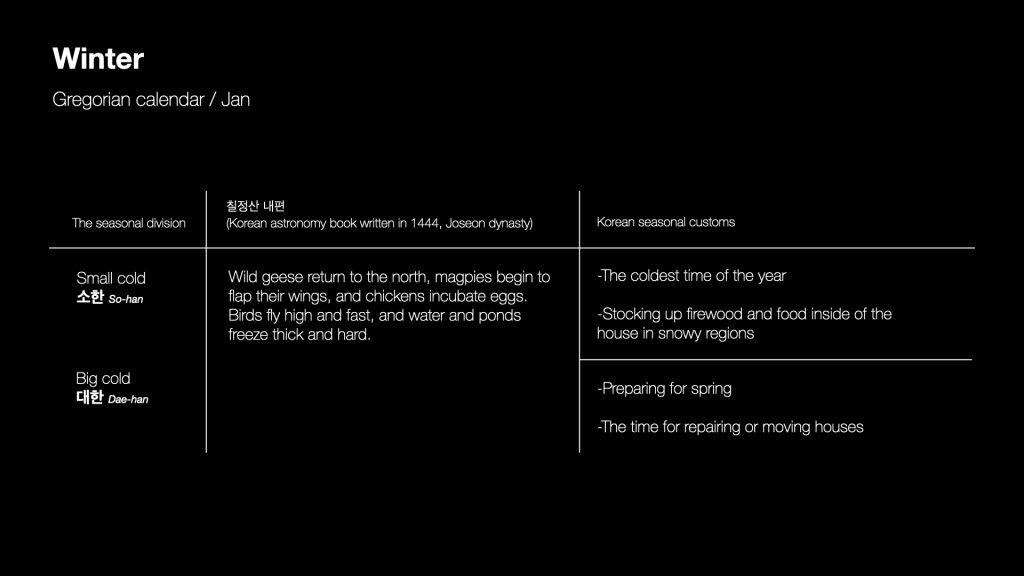
- 소한 So-han (Small cold) So-han means small cold based on the weather in China but it’s actually the coldest time in Korea. Farmers are fully prepared for the freezing cold weather until the beginning of spring. In snowy regions of Korea, people stock up for firewood and food for about a month since it gets difficult to leave the house.
- 대한 Dae-han (Big cold) Dae-han is the last season of the 24 lunisolar seasons, which translates to big cold. Like I mentioned above So-han is colder than Dae-han so people start preparing for spring by repairing houses and organizing house moving.
Reflection
Learning about the Korean calendar that I’ve used my whole life gave me a lot of insight into the aboriginal knowledge in Korea, and its ecological sense of knowing. Paying attention to something that was always in my background helped me recognize how connected Korean people were with the land and other non-human beings in the past. It showed me there is so much dept in my language and culture that I’ve been unconsciously influenced by. It was also interesting how being far away from home allowed me this time and space to reflect on my life experience growing up in Korea. I told my parents about this project and my dad, who grew up farming in a rural area (he is still very connected to the land and natural environment around him), told me these seasonal divisions are still widely used to plan farming throughout the year. However, I’m living in an urban environment of Vancouver, Canada far away from the land I was raised. I don’t own a piece of land where I can practice this knowledge. Now, what are the options for me to experience different perceptions of time?